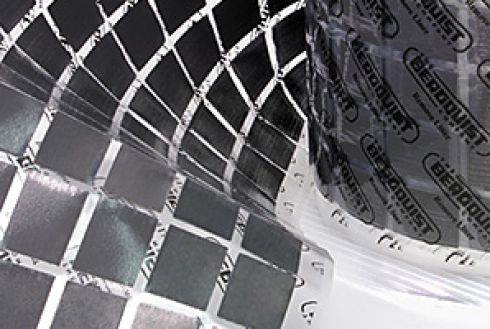Gap Pad
Gap Pad 1500R
Features & Benefits
- Thermal conductivity: 1.5 W/m-K
- Fiberglass reinforced for puncture, shear and tear resistance
- Easy release construction
- Electrically isolating

Properties
| Properties | Imperial Value | Metric Value | Test Method |
|---|---|---|---|
| Reinforcement Carrier | Fiberglass | Fiberglass | *** |
| Color | Black | Black | Visual |
| Inherent Surface Tack | 2 | 2 | *** |
| Density (Bulk Rubber) (g/cc) | 2.1 | 2.1 | ASTM D792 |
| Heat Capacity (J/g-K) | 1.3 | 1.3 | ASTM E1269 |
| Hardness (Bulk Rubber) (Shore 00) (1) | 40 | 40 | ASTM D2240 |
| Young's Modulus (psi) / (kPa) (2) | 45 | 310 | ASTM D575 |
| Typical Use Temp (°F) / (°C) | -76 to 392 | -60 to 200 | *** |
| Thickness (inch) / (mm) | 0.010 to 0.020 | 0.254 to 0.508 | ASTM D374 |
| Electrical | Imperial Value | Metric Value | Test Method |
|---|---|---|---|
| Dielectric Breakdown Voltage (Vac) | >6000 | >6000 | ASTM D149 |
| Dielectric Constant (1000 Hz) | 6.0 | 6.0 | ASTM D150 |
| Volume Resistivity (Ohm-meter) | 10^11 | 10^11 | ASTM D257 |
| Flame Rating | V-O | V-O | U.L. 94 |
| Thermal | Imperial Value | Metric Value | Test Method |
|---|---|---|---|
| Thermal Conductivity (W/m-K) | 1.5 | 1.5 | ASTM D5470 |
| Pressure (psi) | 10 | 25 | 50 | 100 | 200 |
|---|---|---|---|---|---|
| Thermal Impedance (ºC-in2/W) 0.020" | 10: 1.07 | 20: 0.88 | 30: 0.82 |
| Deflection (% strain) | 10 | 20 | 30 |
|---|---|---|---|
| Thermal Impedance (°C-in2/W) 0.020" | 1.07 | 0.88 | 0.82 |
| Thermal Impedance (°C-in2/W) 0.508" (3) | 6.9 | 5.7 | 5.3 |